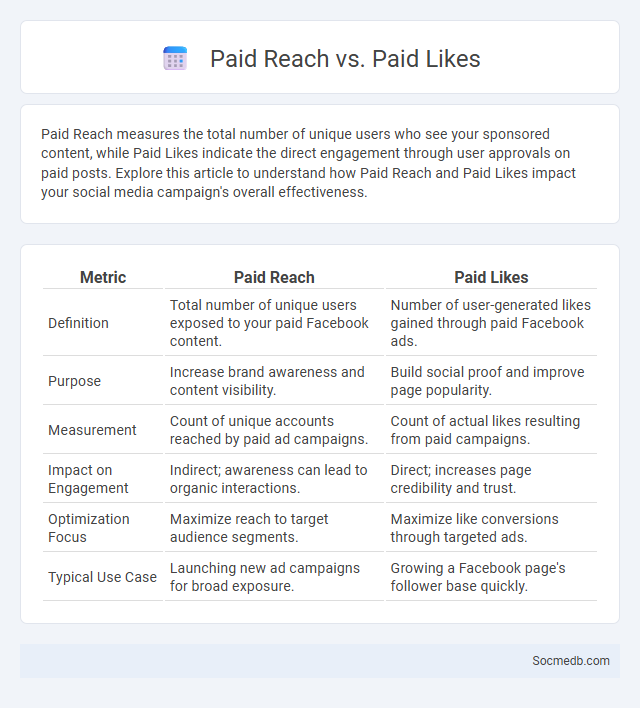
Photo illustration: Paid Reach vs Paid Likes
Paid Reach measures the total number of unique users who see your sponsored content, while Paid Likes indicate the direct engagement through user approvals on paid posts. Explore this article to understand how Paid Reach and Paid Likes impact your social media campaign's overall effectiveness.
Table of Comparison
| Metric | Paid Reach | Paid Likes |
|---|---|---|
| Definition | Total number of unique users exposed to your paid Facebook content. | Number of user-generated likes gained through paid Facebook ads. |
| Purpose | Increase brand awareness and content visibility. | Build social proof and improve page popularity. |
| Measurement | Count of unique accounts reached by paid ad campaigns. | Count of actual likes resulting from paid campaigns. |
| Impact on Engagement | Indirect; awareness can lead to organic interactions. | Direct; increases page credibility and trust. |
| Optimization Focus | Maximize reach to target audience segments. | Maximize like conversions through targeted ads. |
| Typical Use Case | Launching new ad campaigns for broad exposure. | Growing a Facebook page's follower base quickly. |
Understanding Paid Reach: Definition and Benefits
Paid reach on social media refers to the number of unique users who see content as a result of paid advertising efforts, such as promoted posts or sponsored ads. This strategy enables precise targeting based on demographics, interests, and behaviors, increasing the likelihood of engagement and conversion. Benefits of paid reach include amplified visibility beyond organic followers, improved brand awareness, and enhanced ROI through measurable campaign performance.
What Are Paid Likes? Key Features Explained
Paid likes are social media engagements purchased to boost the visibility and credibility of your content quickly. These likes come from real or automated accounts, influencing algorithms to increase reach and attract organic followers. Understanding the key features, such as targeted demographics, delivery speed, and platform-specific policies, helps you make informed decisions about their strategic use.
Paid Reach vs Paid Likes: Core Differences
Paid Reach measures the total number of unique users who see your social media content through paid promotions, while Paid Likes focus specifically on the number of users who actively engage by liking your posts. Your campaign's success can be better evaluated using Paid Reach to understand overall visibility, whereas Paid Likes provide insight into user engagement and content appeal. Focusing on both metrics enables you to optimize ad spend and improve audience targeting strategies.
Cost Analysis: Paid Reach vs Paid Likes
Cost analysis of social media advertising reveals paid reach often yields broader audience exposure per dollar spent compared to paid likes, which target engagement metrics directly. Paid reach campaigns typically generate impressions at lower cost per thousand (CPM), while paid likes focus on increasing social proof and interaction but may incur higher cost per engagement (CPE). Brands optimize budget allocation by balancing these metrics to maximize visibility and user interaction on platforms like Facebook, Instagram, and Twitter.
Target Audience Strategies for Paid Reach
Understanding your target audience is essential for maximizing paid reach on social media platforms. Precise audience segmentation based on demographics, interests, and online behavior enhances ad relevance and boosts engagement rates. Tailoring content to align with your audience's preferences increases conversion potential and optimizes your advertising budget effectively.
Engagement Metrics: Measuring the Value of Paid Likes
Engagement metrics such as paid likes provide valuable insights into your social media strategy's effectiveness by quantifying user interaction and brand visibility. These metrics help distinguish between genuine audience interest and artificially inflated numbers, allowing for better budget allocation and content optimization. Understanding the true value of paid likes enhances your ability to measure ROI and drive meaningful connections with your target audience.
When Should You Use Paid Reach?
Paid reach should be used when targeting specific demographics or expanding brand visibility beyond organic followers, especially during product launches or promotional campaigns. It is effective for driving immediate traffic, boosting engagement, and achieving measurable ROI through precise audience segmentation. Utilizing paid reach amplifies content delivery on platforms like Facebook, Instagram, and LinkedIn, optimizing marketing budget efficiency.
When to Invest in Paid Likes
Investing in paid likes can boost your social media visibility when organic reach plateaus or you launch a new product, ensuring rapid audience engagement. Timing your investment during peak campaign phases or seasonal promotions maximizes return by targeting users already interested in your niche. Monitor your analytics carefully to identify periods when your content underperforms, signaling the optimal moment for strategic paid likes to enhance Your social proof.
Conversion Rates: Paid Reach vs Paid Likes
Paid reach on social media often delivers higher conversion rates compared to paid likes because it targets a broader, more engaged audience likely to take action. Your campaigns can benefit by focusing on paid reach strategies that optimize ad placements, audience segmentation, and call-to-action effectiveness. Metrics such as click-through rate (CTR) and cost per conversion provide precise insights into the performance differences between paid reach and paid likes.
Choosing the Right Approach: Paid Reach or Paid Likes?
Choosing the right approach between paid reach and paid likes depends on Your marketing goals and target audience engagement. Paid reach expands your content's visibility, attracting a broader audience, while paid likes enhance social proof and credibility by boosting the number of interactions on your posts. Analyzing campaign objectives helps determine whether driving awareness or building trust is more effective for Your social media strategy.
 socmedb.com
socmedb.com